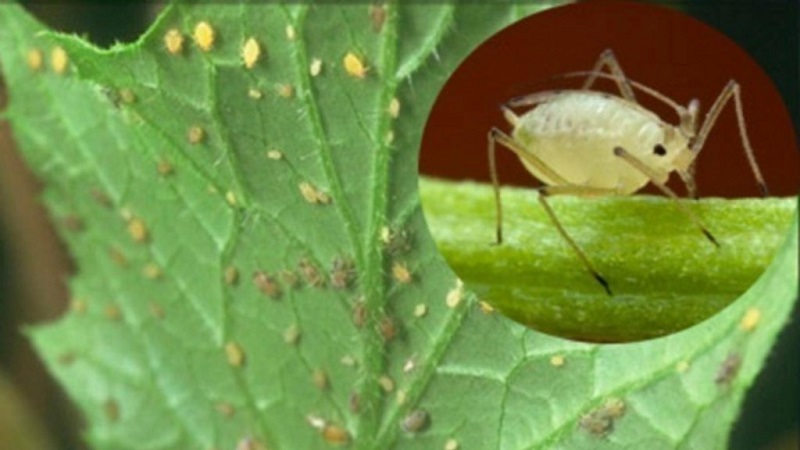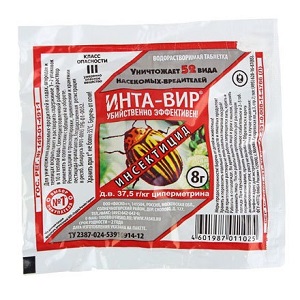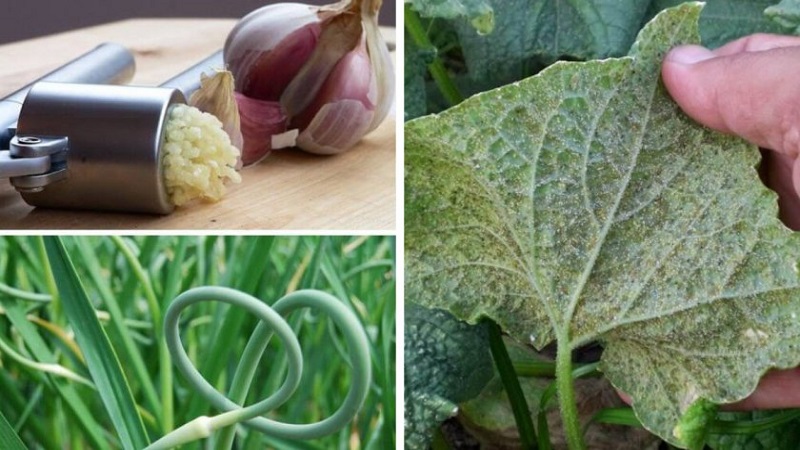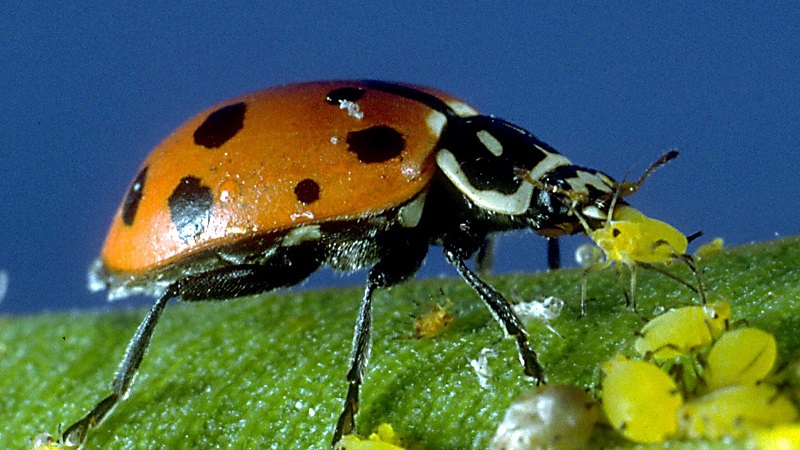How to deal with aphids on cucumbers: the best folk remedies
Aphids are considered one of the most malicious and voracious pests. If measures are not taken in time to destroy the insect, it will cause serious damage to the future harvest. It is not always safe to use professional insecticides in the garden, so farmers use proven home remedies.
How to deal with aphids on cucumbers with folk remedies based on mustard, vinegar and other available substances, we will tell in the article.
The content of the article
Who is aphid and how is it dangerous for cucumbers
Cotton, or melon, aphid (Aphis gossypii) - insects from the order of Hemiptera, polyphagous and cosmopolitan... It is characterized by an incomplete cyclical type of development, it is found everywhere. A dangerous pest of cultivated plants, a carrier of bacteria and viruses.

Insects feed on plant juices and when mass spread cause irreparable damage to the crop. A favorite delicacy of aphids is juicy cucumber leaves. Loss of moisture leads to a delay in the development of plants, wilting, the appearance of fruits later than the expected date.
Aphids affecting cucumbers
Cucumbers in the greenhouse and the garden is affected by green and black aphid... Small bugs have a length of no more than 5 mm - and these are the largest individuals. The standard size of an insect is 2-3 mm. The soft body is covered with growths and hairs. On the forehead there are antennae with organs of touch. The mouth apparatus is in the form of a proboscis, with which the insect pierces the leaves and draws out the juice. On long and thin legs, insects walk and jump. On the abdomen there are juice tubes through which a sticky liquid - honeydew is secreted.
Aphids have excellent terrain and climate adaptability... Larvae and wingless virgins hibernate in the upper soil layers.
Reference. Females reproduce extremely quickly. In the summer, they lay about 50 eggs at a time.
Insect colonies concentrate mainly on the upper tender foliage... The lower leaves have too dense structure, which is "too tough for aphids". In spring, at an air temperature of + 5 ° C, aphids begin to attack young cucumber plantings. Sucking the plant sap, aphids release poison that causes curling, deformation and death of foliage.
Honeydew contaminates the surface of the leaves, disrupts the normal life of the plant. Another danger of aphids for cucumbers is infection with viruses through saliva.

Signs of defeat
At the beginning of the season, it is quite difficult to see small green bugs merging with the green mass. However as the pest spreads, the first signs appear:
- delayed growth and development of cucumbers;
- delayed flowering;
- wilting of the upper foliage;
- twisting and drying of leaves;
- honeydew on greenery;
- accumulation of ants in the area;
- falling off flower ovaries;
- wilting of the lower leaves;
- black or green bugs on the back of the foliage.
Causes of aphids
One of the main reasons for the appearance aphids on site - ants... They are attracted by the sweet and sticky honeydew on the leaves. This is honeydew - a secret secreted by aphids. Moving around the site, ants act as "carriers". They carry bugs on themselves, infecting new plantings.
Reference. Some ant species protect aphid colonies from natural pests and graze them like pets.
Failure to comply with the rules for caring for cucumbers (loosening the soil and removing weeds), thickened planting, poor ventilation in the greenhouse, an excess of nitrogen in the soil contribute to the appearance of aphids.
Basic methods of struggle
Aphid control on cucumbers requires effort, especially in a rapidly increasing population... The most effective are chemical agents of contact-intestinal action. They are used until the time of flowering, since aggressive substances accumulate in flower ovaries, fruits and roots. The use of such a product by a person is dangerous to health.
 Insecticides are available in powder, tablet and liquid form... The substances have a nerve-paralytic effect. The chemicals "Decis", "Inta-Vir", "Aktara", "Tanrek", "Danadim", "Confidor" are popular among gardeners.
Insecticides are available in powder, tablet and liquid form... The substances have a nerve-paralytic effect. The chemicals "Decis", "Inta-Vir", "Aktara", "Tanrek", "Danadim", "Confidor" are popular among gardeners.
Biological products are no less effective against aphids - "Bitoxibacillin", "Aquarin", "Aktofit", "Fitoverm", "Entobacterin", "Strela". They are allowed to be used during the fruiting period. Substances do not accumulate in plant tissues and are completely harmless to humans. Penetrating into the digestive system, they deprive the insect of the opportunity to feed, causing starvation. The products are not addictive to aphids, as is the case with chemicals.
Folk remedies based on herbal decoctions and infusions, vinegar, mustard powder, soap, ash, tobacco, ammonia are suitable for use throughout the growing season. For the best result, it is recommended to alternate and combine them with each other. For example, spraying foliage with garlic infusion is combined with treatment with a solution of mustard powder.
Attention! The action of folk remedies is aimed not at the physical destruction of the pest, but at scaring away.

Folk ways to combat the pest in the greenhouse and in the open field
The table contains effective folk recipes for removing aphids... Processing is carried out in the evening, after sunset, so that the sun's rays do not burn the leaves. The products are suitable for spraying cucumbers in the greenhouse and in the open field.
| Name | Preparation and application |
| Marigold | Fill the bucket halfway with dried flowers, fill with water at room temperature. Insist for two days, strain through cheesecloth and dissolve 40-50 g of soap shavings. Carry out processing 1 time in 7 days. |
| Yarrow | 400 g of raw materials per 1 liter of boiling water. Insist 2 hours and bring the volume to 10 liters. Spray the leaves on both sides once every 10 days. |
| Chamomile | 1 kg of chamomile in 10 liters of water. Insist 5-6 hours and strain through cheesecloth. Process the bushes once a week. |
| Celandine | 250 g of dry raw materials per 10 liters of water. Insist for two days, strain. Spray the bushes once a week. |
| Mustard | 50 g of mustard beans for 5 liters of water. Insist 48 hours, add 5 liters of water and process the planting. The frequency of spraying is 2 times every 10 days. |
| Dandelion roots | 1 kg of dry raw materials per 10 liters of water. Insist 3 hours and process the leaves. The frequency of spraying is once a week. |
| Tomato and potato tops | 500 g of green tops per 10 liters of water. Simmer for 30 minutes. Cool, strain, rub 25 g of liquid soap. Spray the leaves from the bottom and top once a week. |
| Spicy pepper | Take 3 pods for 10 liters of water. Insist for 24 hours in a warm place, strain and stir in 50 g of soap shavings, 100 g of wood ash, 3-5 drops of iodine. The frequency of processing is once every 10 days. |
| Horse sorrel | 300 g of crushed plant roots and 400 g of dandelion leaves in 10 liters of warm water. Insist 2-3 hours, spray 1 time in 7 days. |
| Coniferous extract | Pour 2 kg of pine or spruce needles with 10 liters of water. Insist for 7 days, stirring daily. Dilute 1: 3 with water before processing. The frequency of spraying is once every 10 days. To irrigate row spacings, dilute the concentrate in a 1: 1 ratio. |
| Garlic | 500 g garlic arrows or cloves pour 2 liters of warm water. Insist for a week, use for irrigation of bushes 1 time in 7 days. |
| Horseradish | Take 10-15 crushed roots for 5 liters of boiling water. Insist 5 hours, strain through cheesecloth. Pour the cake into 5 liters of clean warm water, add the first concentrate after 3 hours. For spraying, mix 200 ml of concentrated liquid with 5 liters of water and process. Frequency - once every 10-12 days. |
| Onion peel | Pour a few handfuls of onion husks with 5 liters of warm water, leave overnight. In the morning, strain and add 25 ml of liquid tar soap.
100 g of onion peel and zest of one lemon per 10 liters of water. Insist 3 days. Use for spraying plantings 1 time in 10 days. |
| Tobacco shag | 400 g per 10 liters of boiling water. Insist the solution for 2-3 days and mix in 50 g of soap shavings. Process planting once a week. |
| Wood ash | 200 g of ash and 200 g of shavings of laundry soap per 10 liters of water. Insist 3 hours and process the bushes. Frequency - once a week. |
| Soap solution | Grate 2 pieces of laundry or tar soap and dissolve in 10 liters of warm water. Process the leaves once every 7-10 days. |
| Soda | Dissolve 200 g of baking soda in 5 liters of water, add 20 drops of cedarwood essential oil and process. Frequency - once every 10 days. |
| Milk whey (kefir) | Cucumbers are processed daily until the aphids disappear completely. |
| Ammonia | 2 tbsp. l. 5 liters of water, mix 20 ml of tar liquid soap. Process the leaves on both sides once every 10 days. |
| Vinegar | 100 ml of 9% vinegar, 50 g of shavings of laundry soap per 10 liters of water. Spray the plants once a week. |
| Vodka | Pour alcohol into a spray can and process the bushes. According to the conviction of gardeners, the remedy acts instantly. |
| Coca Cola | Pour the drink into a spray bottle and spray the planting. The destructive effect on aphids is explained by the content of phosphoric acid. |
| Sunflower oil | Mix 200 ml of oil with 1 liter of water and spray the cucumbers immediately. Frequency - 3 times per season. |
Insects are natural enemies of aphids
Praying mantises, ladybugs, wasps, lacewings, hoverflies, ground beetle larvae, earwigs, bedbugs are natural enemies of aphids... To attract beneficial insects to the site, marigolds, oregano, daisies, caraway seeds, allspice, chamomile, dandelions, coltsfoot, parsley, celery, and mint are planted next to cucumbers.
Council. Hang insect houses to attract ladybugs. They can be purchased at gardening stores or you can build them yourself from old logs by drilling holes in them.

Prevention measures
Preventive measures:
- mosquito nets on the windows in the greenhouse;
- covering the beds with agrofibre;
- killing or scaring off ants;
- removal of weeds and plant residues;
- seed treatment in a solution of potassium permanganate or "Fitosporin";
- disinfection of soil with copper sulfate;
- processing of greenhouses with sulfur checkers;
- alternation of means for treating plantings to prevent insect resistance;
- crop rotation;
- sparse fit;
- selection of varieties resistant to aphid attacks;
- fertilization of cucumbers with organics and minerals.
Conclusion
The fight against aphids on cucumbers is hampered by lightning-fast natural reproduction in favorable conditions. The main task of the farmer is to start processing the plantings faster than the pest destroys the crop.
Folk remedies on a plant basis are used throughout the growing season. Solutions and infusions are completely safe for humans and the environment, in contrast to chemicals, the use of which is permitted before flowering. An integrated approach using agrotechnical techniques and spraying plantings allows you to quickly get rid of the pest.